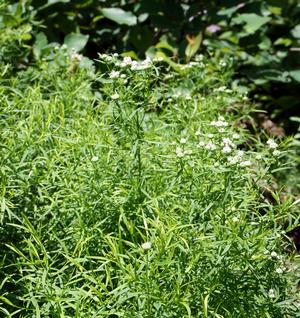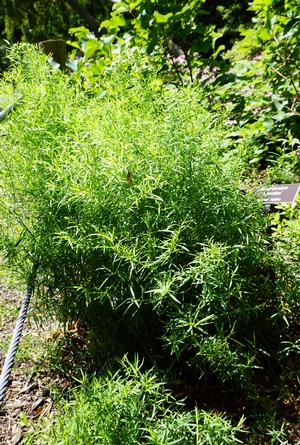Pycnanthemum tenuifolium
Common: narrowleaf mountain mintPycnanthemum tenuifolium 50LP - 50 per flat
- Height: 24"-30"
- Spread: 12"-24"
- Spacing: 12"-18"
- Hardiness Zone(s): 4-8


Pycnanthemum tenuifolium 50LP - 50 per flat

Densely branching with fine foliage and white flowers atop terminal clusters, Pycnanthemum tenuifolium, or slender mountain mint, has a more delicate appearance than P. muticum but with all the same pollinator action. Like its mountain mint brethren, P. tenuifolium spreads generously by rhizome making this plant a wonderful mass of white blooms in late summer.
With multiple different Pycnanthemum available, Pycnanthem tenuifolium stands out in the genus for its ability to withstand drier sites, narrow leaves, and small white flower clusters. Growing 2-3’ tall, P. tenuifolium is well-regarded for its above-average pollinator attraction and the fine foliage lends itself well to a garden setting even before it flowers. Mountain mint’s aroma can be smelled even in the dead of winter and the dried seedheads are attractive in a hard frost.
Pycnanthemum tenuifolium thrives in rocky, dry soils to moist soils along streambanks in full sun to light shade. Found from Canada to Florida and west to Nebraska and Texas, this species is distributed in fields, wet thickets, alluvial ground and gravel bars along streams. More tolerant of dry and rocky soils than other Pycnanthemum species, it is also a bit more aggressive with shallow rhizomes that spread quickly. To ensure a tidier clump, cleave spreading runners with a sharp spade in the spring to maintain size in highly-managed landscapes. Flowers of this species are thought to be so attractive to a wide variety of pollinator species due to its tight flower cluster, short corolla tubes, and white coloring.
A member of the mint family, the aromatic oils in the foliage make Pycnanthemum very deer and rabbit resistant. Mountain mint contains pulegone which is a natural insect repellant. It is a larval host plant for the Gray Hairstreak Butterfly and the flowers are covered in wasps, bees, flies, butterflies, and skippers as it blooms throughout the summer. Good to incorporate along the perennial border, prairie, pollinator garden, rain garden, or near the vegetable garden to entice pollinators and best planted in large clumps where insects can easily move from flower to flower. The strong root systems make a tough soil stabilizer that is great for slopes and streambanks.